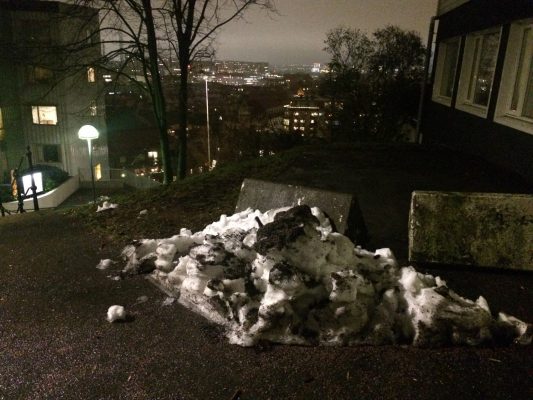Whilst we tend to think of the ice flow in Antarctica as a very slow and steady process, the wonders of satellites have shown over the last two decades it is one of the most dynamic places on Earth! This image of the week maps this dynamical change using all the satellite tools at a scientist’s disposal with novel statistical methods to work out why the change has recently been so rapid. Why do ...[Read More]
Image of the Week — Biscuits in the Permafrost
In Svalbard, the snow melts to reveal a mysterious honeycomb network of irregular shapes (fig. 1). These shapes may look as though they have been created by a rogue baker with an unusual set of biscuit cutters, but they are in fact distinctive permafrost landforms known as ice-wedge polygons, and they play an important role in the global climate. Ice-wedge polygons: Nature’s biscuit-cutter In wint ...[Read More]
Image of the week — Making pancakes
It’s pitch black and twenty degrees below zero; so cold that the hairs in your nose freeze. The Arctic Ocean in autumn and winter is inhospitable for both humans and most scientific equipment. This means there are very few close-up observations of sea ice made during these times. Recently, rapidly declining coverage of sea ice in the Arctic Ocean due to warming climate and the impending likelihood ...[Read More]
Image of the Week — Seasonal and regional considerations for Arctic sea ice changes
The Arctic sea ice is disappearing. There is no debate anymore. The problem is, we have so far been unable to model this disappearance correctly. And without correct simulations, we cannot project when the Arctic will become ice free. In this blog post, we explain why we want to know this in the first place, and present a fresh early-online release paper by Ingrid Onarheim and colleagues in Bergen ...[Read More]
Image of the Week – Geothermal heat flux in Antarctica: do we really know anything?
Geothermal heat flux is the major unknown when we evaluate the temperature and the presence/absence of water at the bed of the Antarctic Ice Sheet. This information is crucial for the Beyond Epica Oldest Ice project, which aims to find a continuous ice core spanning 1.5 million years (see this previous post). A lot of work has been done* to determine geothermal heat flux under the entire Antarctic ...[Read More]
Image of the Week – The world in a grain of cryoconite
Microbes growing on glaciers are recognized for their importance in accelerating glacier melting by darkening their surface and for maintaining biogeochemical cycles in Earth’s largest freshwater ecosystem. However, the microbial biodiversity of glaciers remains mysterious. Today, new DNA sequencing techniques are helping to reveal glaciers as icy hotspots of biodiversity. To see a world in a grai ...[Read More]
Image of the week – How hard can it be to melt a pile of ice?!
Snow, sub-zero temperatures for several days, and then back to long grey days of near-constant rain. A normal winter week in Gothenburg, south-west Sweden. Yet as I walk home in the evening, I can’t help but notice that piles of ice have survived. Using the equations that I normally need to investigate the demise of Greenland glaciers, I want to know: how hard can it be to melt this pile of ice by ...[Read More]
Image of the Week – Understanding Antarctic Sea Ice Expansion
Sea ice is an extremely sensitive indicator of climate change. Arctic sea ice has been dubbed ‘the canary in the coal mine’, due to the observed steady decline in the summer sea ice extent in response to global warming over recent decades (see this and this previous posts). However, the story has not been mirrored at the other pole. As shown in our image of the week (blue line in Fig. 1), Antarcti ...[Read More]
Image of the Week – Searching for clues of extraterrestrial life on the Antarctic ice sheet
Last week we celebrated Antarctica Day, 50 years after the Antarctic Treaty was signed. This treaty includes an agreement to protect Antarctic ecosystems. But what if, unintentionally, this protection also covered clues of life beyond Earth? In this Image of the Week, we explore how meteorites found in Antarctica are an important piece of the puzzle in the search for extraterrestrial life. Meteori ...[Read More]
Image of the Week — Climate change and disappearing ice
The first week of the Climate Change summit in Bonn (COP 23 for those in the know) has been marked by Syria’s decision to sign the Paris Accord, the international agreement that aims at tackling climate change. This decision means that the United States would become the only country outside the agreement if it were to complete the withdrawal process vowed by President Trump. In this context ...[Read More]

